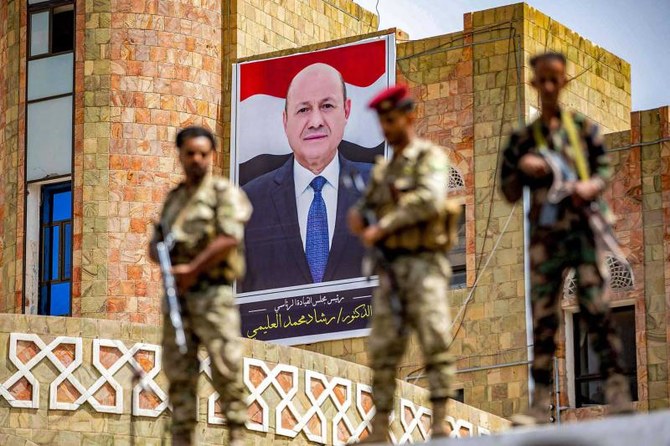Yemen’s truce extension not without its perils

https://arab.news/y3vdf
Despite concerns that Yemen’s truce would not be renewed, the UN on Wednesday announced that the warring parties had agreed to renew the existing deal for another two months. The truce, in its essence, was supposed to build trust among the warring parties to achieve the larger objective of a comprehensive peace settlement. UN Special Envoy for Yemen Hans Grundberg said the extension “includes a commitment from the parties to intensify negotiations to reach an expanded truce agreement as soon as possible.” However, trust remains lacking, as violence on the ground and the lack of action in implementing the government’s requests shakes confidence in the process.
All warring parties in Yemen agreed to the UN truce initiative on April 2 and decided to implement another extension on June 2. The ceasefire was the first nationwide halting of fighting in the seven years of conflict, which started in 2014 when the Houthis descended from their northern territory of Saada and took over the capital, ultimately forcing the government of Abed Rabbo Mansour Hadi to flee to Aden in the south of the country, before its eventual exile to Saudi Arabia. This brought the intervention of a coalition that entered the war in early 2015 to restore the government to power.
This week’s renewal came amid international interest in Yemen and regional stability generally, which was seen following US President Joe Biden’s visit to Jeddah last month, when he announced an agreement to “deepen and extend” the truce. More recently, Secretary of State Antony Blinken spoke with Rashad Al-Alimi, head of the Presidential Leadership Council, to press for the truce renewal.
But this extension did not come about easily. The Houthis initially rejected the extension and intensified their objections, mainly after Biden visited Jeddah, as part of their strategy to influence the US to abandon its interest in Yemen and the region. As stated by the Houthis’ ruling political council: “We reject any outcomes for the American president’s visit to the region that touch the sovereignty, security and stability of Yemen.” The renewal announcement happened after three days of talks with the Houthi leadership by an Omani delegation in Sanaa, which seemed to secure the Houthis’ acceptance.
In the past two months, nongovernmental monitors have reported a ‘slowdown’ in the implementation of the ceasefire.
Fatima Abo Alasrar
Under the truce, there has been an overall decrease in violence and an improvement in the living conditions for many Yemenis, as international organizations have reported a reduction in the number of civilians killed and injured. This figure dropped by more than 50 percent in the first month of the truce. Moreover, cross-border attacks into Saudi Arabia have also diminished, mainly due to Houthi compliance. However, despite the easing of humanitarian suffering, the truce has not been without its perils, as militia violations inside Yemen have continued in different areas. In the past two months, nongovernmental monitors have reported a “slowdown” in the implementation of the truce.
Most alarming is that attacks on civilians have continued in various parts of the country, particularly in Taiz. The UN special envoy’s office has been aware of these violations and condemned the Iran-backed Houthi militia’s attack that hit the Zaid Al-Moshki residential neighborhood in Taiz last month, injuring 11 children, mainly under the age of 10, and killing one boy. None of this instills confidence in the current process and its ability to generate a fair political settlement in the long run.
These incidents have been scattered throughout the country. According to the Yemen Truce Monitor, there were 1,806 violations between April 2 and July 29 — 1,680 of which were attributed to the Houthis. This is 93 percent of the reported cases. Moreover, their failure to lift the years-long blockade of the city of Taiz, which has been a main condition of Yemen’s government, has unfortunately not been met.
The main components of the truce were designed to accommodate the Houthis’ demands in exchange for the opening of roads around Taiz, Yemen’s third-largest city, which would improve the humanitarian conditions in the blockaded city. Yemen’s government agreed to resume commercial flights from the militia-held capital Sanaa to Amman and Cairo twice a week, while an increased number of oil tankers have been allowed to enter the port of Hodeidah, which is also under the control of the Houthis. Although more than 8,000 passengers have traveled and more than 24 ships have entered the port, there are yet to be any visible signs of progress on the issue of Taiz.
Peace initiatives that are undertaken to ease the humanitarian suffering in Yemen are always welcome. The cessation of violence, even if momentary, provides the country and the region with some respite and allows people to experience a relative degree of freedom from the fighting. But the overall objective of reaching a lasting political settlement should be evaluated, as the commitment to peace from the Houthi side remains questionable.
- Fatima Abo Alasrar is a Non-Resident Scholar at the Middle East Institute and a Senior Analyst at the Washington Center for Yemeni Studies. Twitter: @YemeniFatima









































